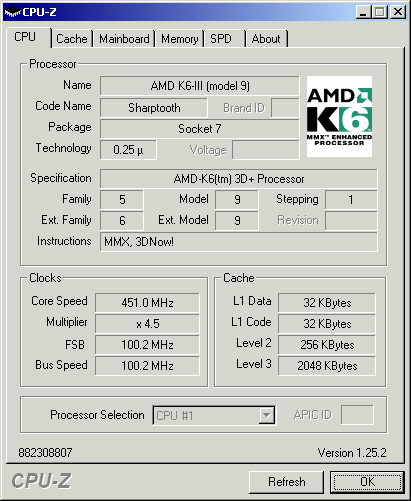The Mother of All CPU Charts Part 1
1998 To 2000, Continued
After Intel had its Pentium MMX on the market, AMD with followed with its K6, which worked with up to 166 MHz and also offered MMX. For the first time, SDRAM memory was supported, bringing about a quantum leap in memory transfer. There were modules with 60 ns (EDO) or 70 ns (Fast Page). Memory transfer rates of up to 90 MB per second were reached, and the maximum memory expansion was now 384 MB, later 768 MB. Almost at the same moment, the ATX form factor was introduced. Moreover, a new power supply specification allowed the computer to enter a standby mode or to be switched on and off using software. The introduction of the AGP interface brought more speed compared to the standard PCI. At that time, when memory was still very expensive and slow, it occurred to Intel that graphics cards could get direct access to RAM.
Intel ended the Socket 7 era with the Pentium 233 MMX, which had a maximum heat loss of 17 watts. The manufacturer had been planning the Pentium 266 MMX, and then used it only as a mobile variation. Unlike Intel, which by this time was relying on Slot 1, AMD used Socket 7 for another two years. The last Socket 7 processor was the AMD K6-III 500 or the AMD K6-2+ 550. In performance, the AMD K6-III 500 beat many a Pentium III (!). The reason? The CPU has an 256 kB integrated L2 cache - when it interacted with a 2 MB L3 cache on the motherboard, this CPU was the absolute killer in performance. At this time Intel had nothing to rival it, especially since the AMD CPU (K6-III 450) could be had considerably cheaper.
Curious and decadent: Pentium 100 with 512 MB RAM - it simply goes with it
Many an application taken for granted today can no longer run without MMX.
The flip side of the coin: after the 500 MHz version of the K6-III was introduced, AMD recalled the processor immediately - even THG returned the rare design. And another unusual feature: Only OEM manufacturers received the K6-2+ manufactured in 180 nm. It was also available in retail stores, but did not run on all motherboards. >From time to time, this CPU was also used in notebooks. At this point, Intel and AMD parted ways. Intel moved to Slot 1 and AMD settled on the similar-looking but incompatible Slot A.
Get Tom's Hardware's best news and in-depth reviews, straight to your inbox.
Current page: 1998 To 2000, Continued
Prev Page 1998 To 2000: Socket 7 - AMD CPUs Next Page 1998 To 2000, ContinuedTom's Hardware is the leading destination for hardcore computer enthusiasts. We cover everything from processors to 3D printers, single-board computers, SSDs and high-end gaming rigs, empowering readers to make the most of the tech they love, keep up on the latest developments and buy the right gear. Our staff has more than 100 years of combined experience covering news, solving tech problems and reviewing components and systems.
-
Rare Intel Pentium P5 wafer with chips:Reply
http://www.chipsetc.com/intel-journey-inside-educational-chip-kits.html




